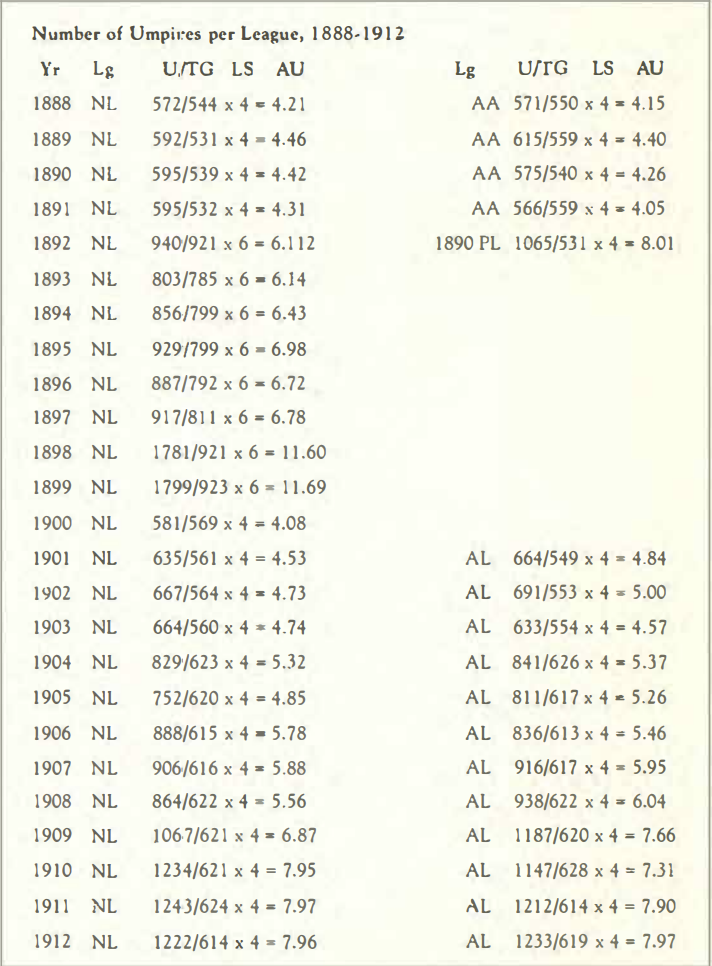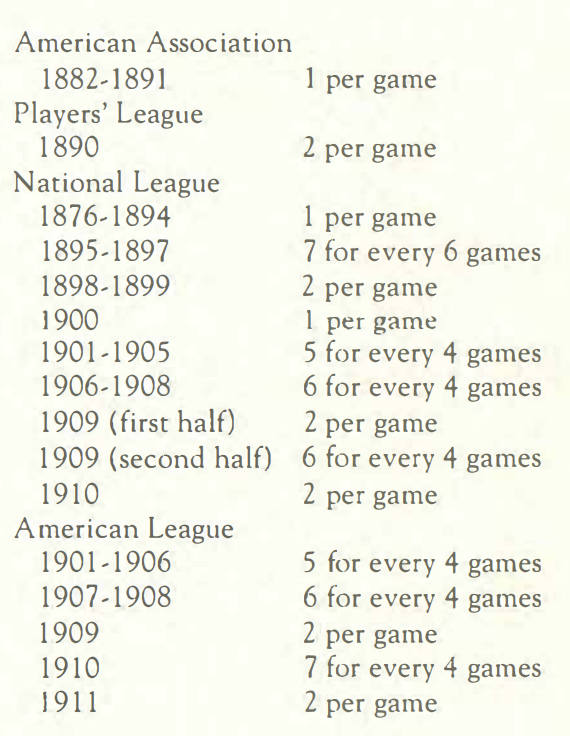From One Ump to Two
This article was written by John Schwartz
This article was published in 2001 Baseball Research Journal
When professional baseball began, one umpire was assigned to each game. By the 1911 season, both major leagues had adopted the two-umpire system. The transition between the one-umpire system and the use of two officials per game was at times abrupt, at times gradual. It took three tries for the double umpire system to become established.
To track the changeover, I examined every box score in the transition period, 1889-1911, and in a few seasons before and after, and recorded the names of the umpires. I divided the number of umpires’ names (U) by the number of total games (TO). This number was multiplied by a figure I refer to as “league size” (LS) which is the number of games that could cake place at the same time (four for an eight-team league, six for a twelve-team league). The result takes into account both long-term and short-term umps, permanent staff and temporary fill-ins, and yields the average number of umpires working on a day when all a league’s teams were in action. The accompanying table sets forth the results.
Through 1889, the one-umpire system was in use. Two umps worked some games in 1888, and even more in 1889. The ratio never reaches 4.5, though, let alone 8.
The 1890 season saw the first season-long use of the double-umpire system. This season was fraught with irony. The best players and umpiring were in the Players’ League, the only league that adopted the two-ump system, yet the ”World’s Series” was played between the champions the National League and American Association, the second- and third-best leagues (another irony: it ended in a tie). As the Fifth Edition of Total Baseball states (page 2,390): “Leave it to the players to understand the importance of having at least two umpires on the field of play.”
When the Players’ League folded, the NL and the AA threw the baby out with the bathwater. In 1891, the one-umpire system was back in both leagues. The AA collapsed after the 1891 season, and a twelve-team “League-Association” was formed; in effect, an enlarged National League. For the first three seasons of the twelve-team NL, the one-umpire system remained in effect, but the number of umpires was increasing. By 1895, and through the 1897 season, the league employed seven men for every six games, providing a little (very little) extra coverage.
The 1890s are generally recognized as the peak years for umpire abuse. Owners undermined umpire authority by paying fines for players umpires tried to discipline. Owners, while giving lip service to efforts to eliminate rowdyism, pandered to anti-umpire sentiment because they felt umpire baiting would increase their profits.
The National League adopted the double-umpire system in 1898. The experiment lasted two seasons. When the league contracted to eight teams in 1900, it once again regressed to the one-umpire system.
Ban Johnson declared his American League “major” in 1901, and both the AL and NL had five-man staffs available for every four games. This continued in the NL until 1905, and the AL until 1906. From 1906 through 1908, the NL had a six-man staff. The AL went to six for 1907 and 1908. In 1909, the National League moved up to a seven-man staff, and the American had eight men, in effect, two men per game.
In 1910, the NL went to the double-umpire system, never to regress. The AL slipped back to seven umpires. In 1911, both leagues had eight-man staffs. The players realized that the game had outgrown the one umpire system by 1890; it took twenty years for the major leagues to catch up.
This state of affairs would continue until 1921 in the American League and 1923 in the National League, when umpiring staffs again began to increase. A summary of the transition to two-man umpiring crews:
Ump tales
The World Series of 1888 was ten games long, but the New York Giants of the National League had won six of the first eight games. The umpires were John Kelly of the NL and John Gaffney of the American Association. The ninth and tenth games, which would not affect the outcome of the Series, were played in St. Louis. Kelly did not bother to stay around, and Gaffney worked them by himself. Tn 1889, the umpires chosen to work the New York NL, Brooklyn AA World Series were Gaffney and Tom Lynch, of the NL. Lynch staged a holdout for more money, so the first game was worked by Gaffney and Bob Ferguson, both AA umpires. Lynch came to terms, and he and Gaffney worked the rest of the games. During the 1910 season, Jack Sheridan, senior American League umpire (he was on the staff in 1900, before the AL was a major league) resigned in June, but returned in late August. When he came back he was strictly a base umpire, yet he was chosen to work the World Series that year. It is the only time in World Series history since 4 umps were assigned to games that one of the four did not take a turn calling balls and strikes.




